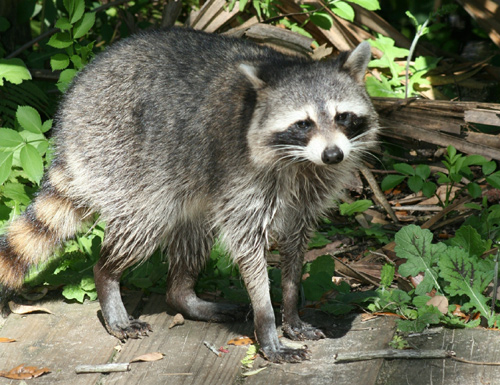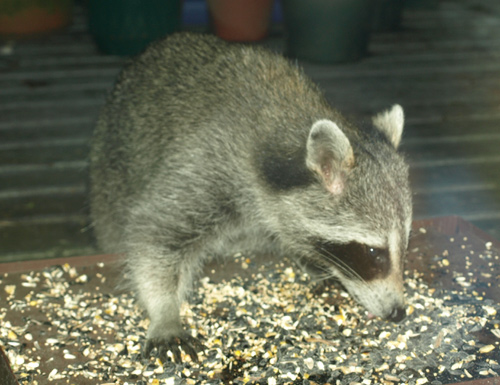Raccoons are extremely common in Connecticut and are gray-brown or silvery, grizzled gray. Their most distinguishing features are the black mask of fur across their eyes that is edged with white and their bushy, 7 1/2 to 16 inch, black-ringed tail. Their faces have pointed snouts and their dextrous, long-fingered paws look like tiny hands.
Raccoons range through nearly the entire continental US, except for some sections of the Rocky Mountains. They prefer forest habitat and like to live near water. However, they are very adaptable and will also live in farmland, residential areas and cities. Raccoons are nocturnal, but healthy raccoons may be seen out in the daytime. They are not active during the winter; they retire to a den where they spend the cold months in a lethargic sleep. However, on milder days they may come out for awhile.
Raccoons are omnivorous and very opportunistic feeders. They eat nuts, fruit, berries, grubs, insects, voles, mice, eggs, nestlings, fish, crayfish, garden vegetables, crops, birdseed and garbage. In the fall a Raccoon's appetite increases and it can gain up to 1/3 of its weight in fat for the winter as it does not feed during this period.
Raccoons mate in January through March. In these months male raccoons leave their winter dens and look for females. They move into the den of a receptive female and spend a week or two wooing her. Once they have mated the female goes back to sleep. The male may be active for awhile before he settles back to sleep until spring arrives. Raccoons are not monogamous and only the female tends the babies. Cubs are born in April or May, and litters usually contain about 4 young.
Raccoons are solitary most of the time. The exceptions are during breeding, while mothers are raising cubs, and communal denning in the winter which is common. They den in tree hollows, abandoned burrows, rock crevices, brush piles, abandoned beaver lodges, or buildings. Dens are used in the winter, for raising cubs and for temporary shelter. Raccoons are often seen dabbling in the water with food. It is believed they are not washing it but separating out inedible bits, especially for things caught in the water. Raccoons can purr, whimper, growl, snarl, hiss and shriek. A raccoon squabbling with another raccoon or animal can create quite a cacophony.
The raccoon's dexterity can make it particularly pesky. Those long, nimble fingers are capable of manipulating objects, opening garbage cans, turning knobs, working latches and getting into things humans wish they wouldn't. They are a great adaptation for an opportunistic forager. As usual, the most common source of human/raccoon conflict is the raccoon's quest for food. As with bears, the best way to avoid conflicts is to remove or adequately contain food sources near your house that will tempt raccoons. As you can see in my photo, a tray of birdseed left out one night brought a masked bandit to my deck.
In another personal experience, I installed a very small garden pond of only about 100 gallons in my back yard. I added some potted aquatic plants and tossed in a bunch of small, cheap goldfish to control mosquitos. A few nights later I looked out and saw a raccoon family, a mother and 4 cubs, gamboling in my shallow pond. They were all crammed in there and they barely had elbow room. They were busily pulling out every pot, pulling the plants out of the pots and looking them over, turning over the rocks and probably catching the fish. They were having such a good time and were so entertaining I didn't have the heart to disturb them. The next morning it looked like a small tornado had been through the pond. I just replaced everything. The scene was repeated for a couple nights, then the raccoons seemed to feel they had examined everything and acquired any possible foods. Although they came by to drink, they didn't wreak chaos in there again. Amazingly a number of the goldfish survived
Rabies can afflict all mammals, and raccoons are a major vector of rabies in Connecticut. One shouldn't approach wild animals anyway, but raccoons or other animals behaving strangely and exhibiting symptoms such as lethargy, unprovoked aggression, apparent disorientation, lack of coordination or lack of fear should be particularly avoided. If you suspect a rabid raccoon is on your property, contact the Connecticut DEP or your local animal control officer. Rabies spreads to other mammals (including humans) through bites or other contact with infected saliva. Untreated rabies is always fatal, so it is a disease that must be taken seriously.
Keep in mind that raccoons out in the daytime are not necessarily sick. Healthy raccoons are sometimes active in daytime, especially mothers who are busy caring for young.
Neat Fact
Both the raccoon's common name and scientific name refer to its dexterity with its paws. "Raccoon" is believed to have originated from the Algonquin Indian word "aroughcoune" which means "he scratches with his hands". The Latin species name for raccoons, lotor, translates into "washer".

